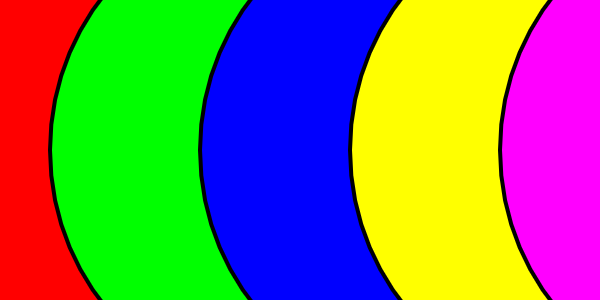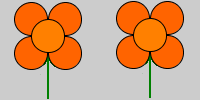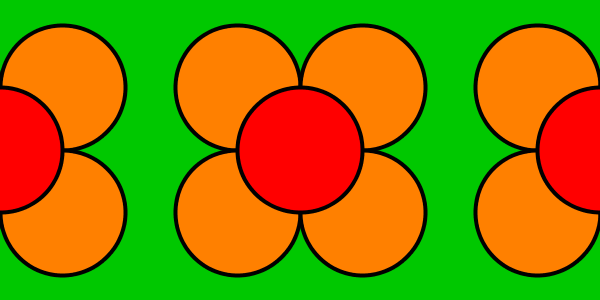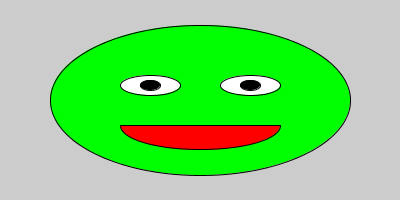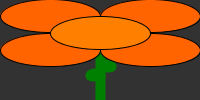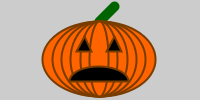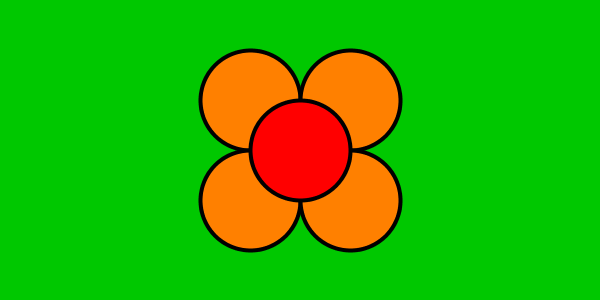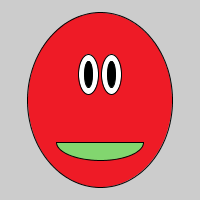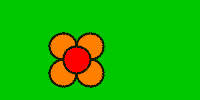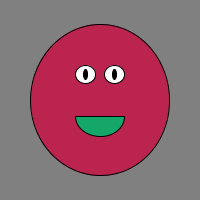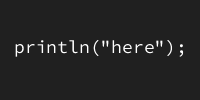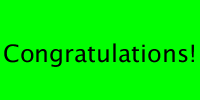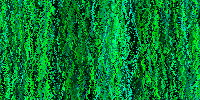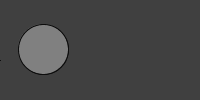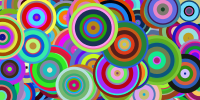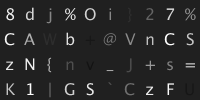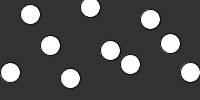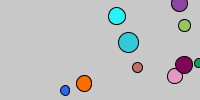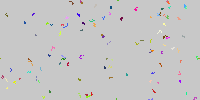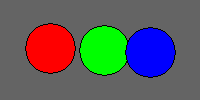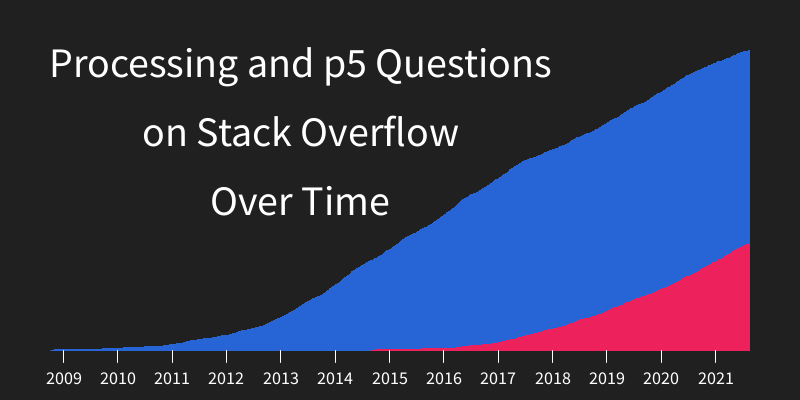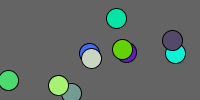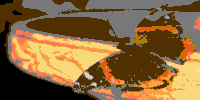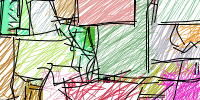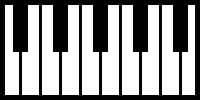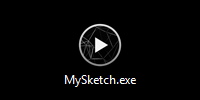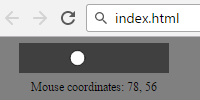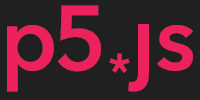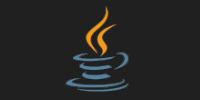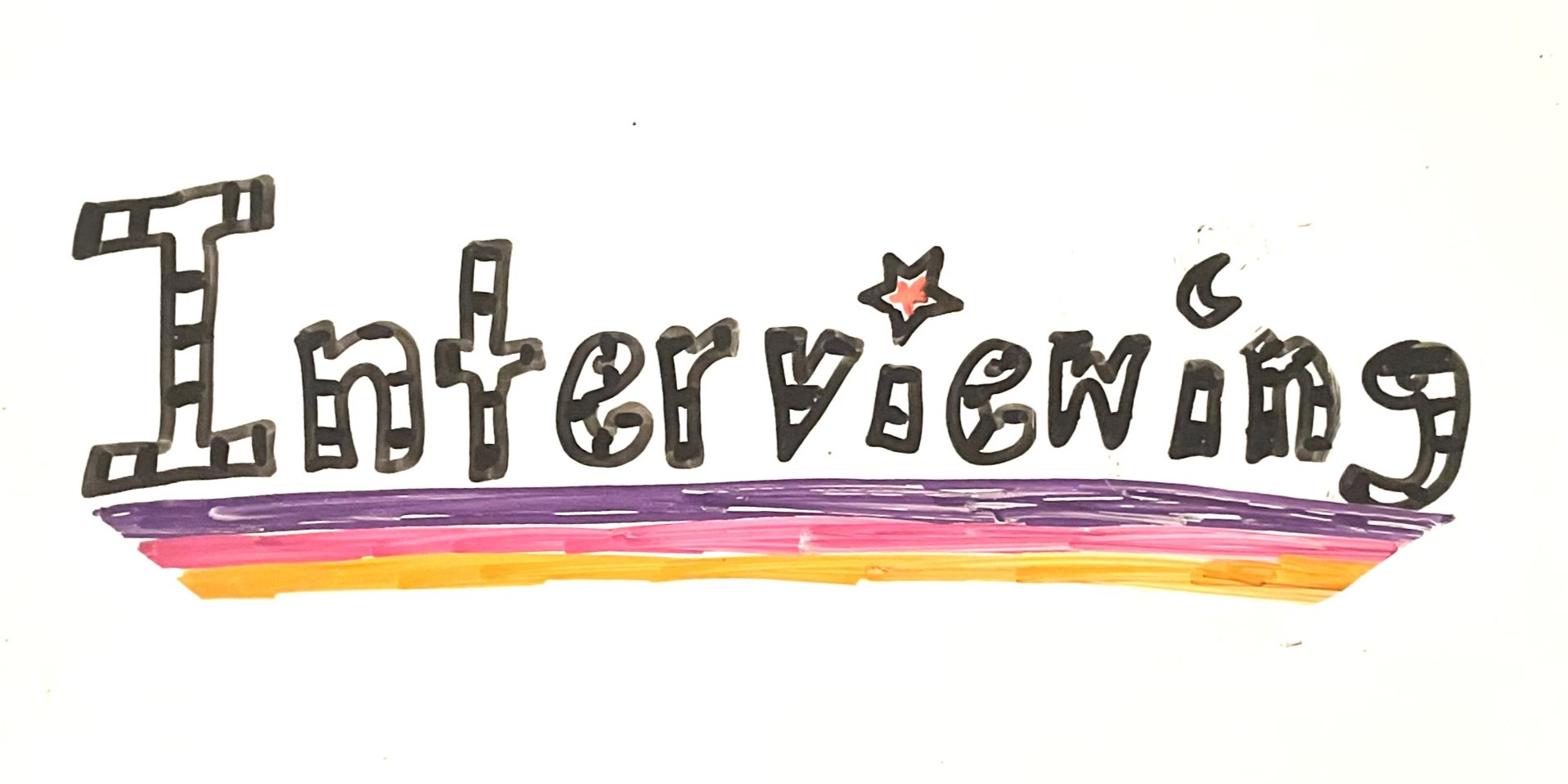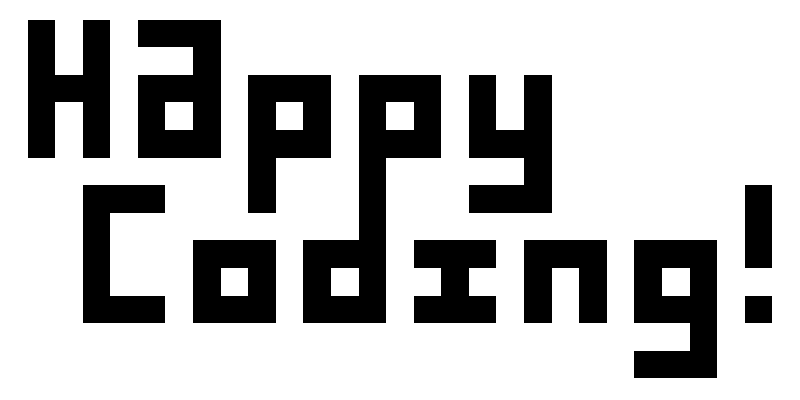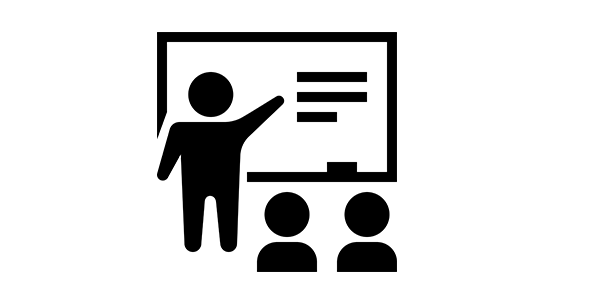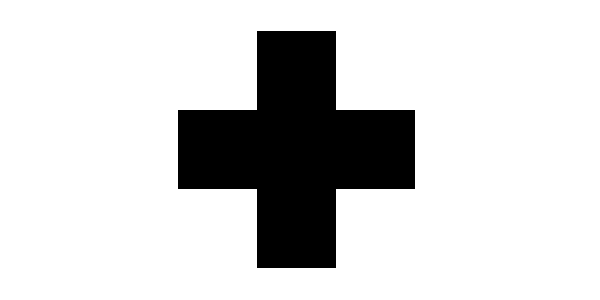Input
Input
Now you know how to call functions, use variables, create functions, and use if statements. You also know how to modify variables over time to create animations, and you’ve seen that Processing gives you predefined variables like width and height.
You also know that Processing automatically calls the setup function once at the very beginning of the program, and then calls the draw function 60 times per second.
So far your programs have mostly done stuff on their own, without responding to anything that the user does. This tutorial shows you how to get user input (things like mouse position, mouse clicks, and keyboard typing) to make your programs more interactive.
Mouse Input
The mouseX and mouseY Variables
Processing provides mouseX and mouseY variables that hold the current location of the mouse cursor in the window. Processing automatically updates these variables, so you can use them in the draw function to get the position of the mouse.
void setup() {
size(300, 300);
}
void draw() {
background(32);
ellipse(mouseX, mouseY, 50, 50);
}
This program draws a circle wherever the mouse cursor is.

See the Pen by Happy Coding (@KevinWorkman) on CodePen.
The mousePressed Variable
The mouseX and mouseY variables point to int values that hold the current position of the mouse.
Similarly, the mousePressed variable points to a boolean value that’s true when the mouse is pressed, and false when it’s not. You can use the mousePressed variable in an if statement to do stuff when the mouse is held down:
void setup() {
size(300, 300);
}
void draw() {
if (mousePressed) {
background(0, 255, 0);
} else {
background(32);
}
}
This program uses an if statement to check whether mousePressed is true. If it is, then it draws a green background. If not, then it draws a gray background.

In other words, the program displays gray unless the mouse is pressed, then it displays green.
You can combine the mousePressed variable with the mouseX and mouseY variables to create a drawing program:
void setup() {
size(300, 300);
background(32);
}
void draw() {
if (mousePressed) {
ellipse(mouseX, mouseY, 25, 25);
}
}
This program uses an if statement to check whether mousePressed is true. If it is, then it draws an ellipse at mouseX,mouseY.

In other words, the program lets you draw with circles whenever the mouse is pressed.
This works because the code does not call the background function from the draw function, so new circles are drawn on top of old circles.
See the Pen by Happy Coding (@KevinWorkman) on CodePen.
Mouse Input Functions
The mousePressed variable is useful when you want to do something continuously, as long as the user has the mouse pressed. But what if you want to detect one-time input like a mouse click?
These one-time inputs are called events, and Processing provides a bunch of functions that it automatically calls whenever an event happens. By writing code inside these functions, you can run code when these events happen.
There are a bunch of mouse input functions that allow you to react to more specific events:
mousePressed()is called once when the user presses the mouse button. This is the first half of a click.mouseReleased()is called once when the user releases the mouse button. This is the second half of a click.mouseClicked()is called when the mouse is clicked. This is a press and a release!mouseMoved()is called whenever the mouse moves.mouseDragged()is called, you guessed it, whenever the mouse is moved while its button is pressed.mouseWheel()is called when you scroll with the mouse wheel.- If you need to know which mouse button is pressed, check out the
mouseButtonvariable.
Here’s an example that defines mousePressed, mouseReleased, and mouseDragged functions to change the background color:
float r = 32;
float g = 32;
float b = 32;
void setup() {
size(300, 300);
}
void draw() {
background(r, g, b);
}
void mousePressed() {
r = 0;
g = 255;
b = 0;
}
void mouseReleased() {
r = 255;
g = 255;
b = 0;
}
void mouseDragged() {
r = 0;
g = 0;
b = 255;
}
The program starts out gray. When the user presses their mouse, it turns green, and then turns yellow when the user releases their mouse. The program turns blue when the user drags their mouse.
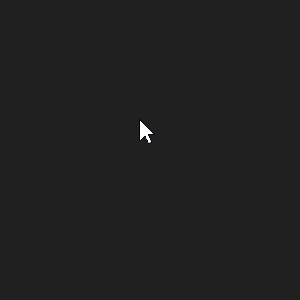
See the Pen by Happy Coding (@KevinWorkman) on CodePen.
Combining Input Variables and Event Functions
Inside an event function, you can use the same variables and functions as you can in the draw function. Here’s an example that uses the mouseX and mouseY variables inside the mouseClicked function:
void setup() {
size(300, 300);
background(32);
}
void draw() {
if (mousePressed) {
fill(0, 255, 255);
ellipse(mouseX, mouseY, 25, 25);
}
}
void mouseClicked() {
fill(0, 255, 0);
ellipse(mouseX, mouseY, 50, 50);
}
Inside the draw function (which is called 60 times per second), this code checks the mousePressed variable and draws a small cyan circle under the mouse if it is. Inside the mouseClicked function (which is called once when the user clicks their mouse), the code draws a large green circle under the mouse. In other words, the user can hold down their mouse to draw a small cyan circle, or they can click their mouse to draw a large green circle

See the Pen by Happy Coding (@KevinWorkman) on CodePen.
Keyboard Input
The keyPressed Variable
Similar to how the mousePressed variable is true whenever the user is pressing a mouse button, the keyPressed variable is true whenever the user is pressing a key on the keyboard.
You can use the keyPressed variable in an if statement to execute code whenever the user is pressing a key:
void setup() {
size(300, 300);
}
void draw(){
if(keyPressed){
background(0, 255, 0);
}
else{
background(100);
}
}
This program uses an if statement to check whether the keyPressed variable is true. If so, then it draws a green background, otherwise, it draws a gray background.

In other words, the program shows green whenever the user presses a key.
The key Variable
The keyPressed variable by itself is useful if you want to know whether any key is pressed. Many programs will also want to know which key is being pressed. For that, you can use the key variable.
The key variable is a char type. If you haven’t seen the char type yet, it’s similar to the String type, except it only holds a single character.
You can use char values by typing a single character inside single quotation marks '', like this:
char myCharVariable = 'A';
The key variable points to a char value that holds the last key that was pressed.
You can use it directly:
void setup() {
size(300, 300);
}
void draw(){
background(32);
textSize(144);
text(key, 110, 180);
}
This program passes the key variable into the text() function to draw the last key typed by the user.

See the Pen by Happy Coding (@KevinWorkman) on CodePen.
Or you can use the key variable in an if statement to detect particular key presses:
void setup() {
size(300, 300);
}
void draw() {
if (keyPressed) {
if (key == 'r') {
background(255, 0, 0);
}
else if (key == 'g') {
background(0, 255, 0);
}
else if (key == 'b') {
background(0, 0, 255);
}
}
else {
background(32);
}
}
This program uses an if statement to check whether keyPressed is true. If so, then it uses another if / else-if block to check whether they key is r, g, or b. Depending on which key is pressed, it draws a different color background. If keyPressed is false, then it doesn’t bother checking the key variables and draws a gray background.

See the Pen by Happy Coding (@KevinWorkman) on CodePen.
Notice that the code only checks the key variable if it knows that keyPressed is true. This is because key always holds the most recent key pressed by the user, even if the user stopped pressing it.
Challenge: Modify this code so the color change remains, even when the user releases the key.
The keyCode Variable
They key variable is useful if you want to check for letter or number keys. But what if you want to check for the shift or ctrl key, or the arrow keys? They don’t have char representations, so the key variable won’t work with them.
Instead, you can use the keyCode variable. You can check the keyCode variable against predefined variables like UP, DOWN, LEFT, RIGHT, SHIFT, CONTROL, and ALT (There are more, check the reference!) to do stuff when the user presses a specific key.
float circleX = 150;
float circleY = 150;
void setup() {
size(300, 300);
}
void draw() {
background(50);
if (keyPressed) {
if (keyCode == UP) {
circleY--;
}
else if (keyCode == DOWN) {
circleY++;
}
else if(keyCode == LEFT){
circleX--;
}
else if(keyCode == RIGHT){
circleX++;
}
}
ellipse(circleX, circleY, 50, 50);
}
This program checks whether one of the arrow keys is being pressed, and moves a circle based on that. This allows the user to move the circle around the screen.
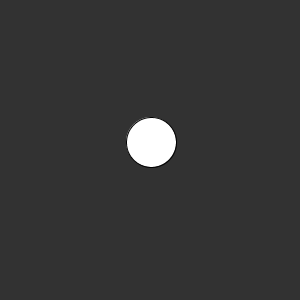
See the Pen by Happy Coding (@KevinWorkman) on CodePen.
Challenge: Modify this code to make the circle go faster!
Keyboard Input Functions
The keyPressed, key, and keyCode variables are useful if you want to do something continuously, as long as the user presses a key. But what if you want to respond to one-time keyboard events?
Similar to how Processing automatically calls the mousePressed(), mouseReleased(), and mouseClicked() functions based on mouse events, Processing also automatically calls the keyPressed(), keyReleased(), and keyTyped() functions based on keyboard events.
You can define these functions to run code based on these keyboard events.
String message = "";
void setup() {
size(300, 300);
textSize(36);
}
void draw() {
background(50);
text(message, 25, 150);
}
void keyTyped() {
message += key;
}
This program maintains a message variable. In the keyTyped function, it appends the typed key to the message variable. The draw function draws the message to the screen.

Handling Multiple Keys
The key and keyCode variables only hold the most recent key pressed. This limits you to only knowing about one key at a time. But what if the user is holding down multiple keys at the same time?
One approach to track multiple keys involves four steps:
- Declare sketch-level
booleanvariables, one for each key you want to track. - In the
keyPressedfunction, detect which key was pressed and set the correspondingbooleanvariable totrue. - In the
keyReleasedfunction, detect which key was released and set the correspondingbooleanvariable tofalse. - In the
drawfunction, useifstatements to do stuff based on thosebooleanvariables.
boolean upPressed = false;
boolean downPressed = false;
boolean leftPressed = false;
boolean rightPressed = false;
float circleX = 150;
float circleY = 150;
void setup() {
size(300, 300);
}
void draw() {
background(50);
if (upPressed) {
circleY--;
}
if (downPressed) {
circleY++;
}
if (leftPressed) {
circleX--;
}
if (rightPressed) {
circleX++;
}
ellipse(circleX, circleY, 50, 50);
}
void keyPressed() {
if (keyCode == UP) {
upPressed = true;
}
else if (keyCode == DOWN) {
downPressed = true;
}
else if (keyCode == LEFT) {
leftPressed = true;
}
else if (keyCode == RIGHT) {
rightPressed = true;
}
}
void keyReleased() {
if (keyCode == UP) {
upPressed = false;
}
else if (keyCode == DOWN) {
downPressed = false;
}
else if (keyCode == LEFT) {
leftPressed = false;
}
else if (keyCode == RIGHT) {
rightPressed = false;
}
}
This code uses four boolean values to hold whether any of the arrow keys are pressed. In the keyPressed function, the corresponding variable is set to true, and in the keyReleased function, the corresponding variable is set to false. Then the draw function uses those variables to move the circle depending on which arrow keys are currently pressed.

See the Pen by Happy Coding (@KevinWorkman) on CodePen.
If this seems confusing, think about exactly what happens when you press two keys at the same time: it might seem like you’re pressing them at the same time, but you’re actually pressing one a split second before the other. Same with releasing them.
Cheat Sheet
This program shows a bunch of the variables and event functions you can use to get user input:
void setup(){
size(300, 300);
}
void draw() {
background(50);
textSize(18);
fill(0);
text("mousePressed: " + mousePressed, 20, 20);
text("mouseButton: " + mouseButton, 20, 40);
text("mouseX: " + mouseX, 20, 60);
text("mouseY: " + mouseY, 20, 80);
text("pmouseX: " + pmouseX, 20, 100);
text("pmouseY: " + pmouseY, 20, 120);
text("keyPressed: " + keyPressed, 20, 140);
text("key: " + key, 20, 160);
text("keyCode: " + keyCode, 20, 180);
}
void keyPressed() {
println("keyPressed: " + key);
}
void keyReleased() {
println("keyReleased: " + key);
}
void keyTyped(){
println("keyTyped: " + key);
}
void mousePressed(){
println("mousePressed");
}
void mouseReleased(){
println("mouseReleased");
}
void mouseClicked(){
println("mouseClicked");
}
void mouseMoved(){
println("mouseMoved");
}
void mouseDragged(){
println("mouseDragged");
}
void mouseWheel(){
println("mouseWheel");
}
Notice that it doesn’t really make sense to display the value of some of these variables (like keyCode or mouseButton). It only makes sense to compare them to other preexisting variables (like SHIFT or LEFT).
Homework
- Create a drawing program. Be creative! Maybe clicking creates a circle, dragging creates a rectangle, and the keyboard changes the color. These are just suggestions, do whatever you want!
- Create a drawing program for a specific scene. For example, you could create a garden drawing program where clicking creates flowers (randomly sized and colored?), dragging creates grass, the mouse wheel adds butterflies, keyboard changes the background or sky…
- Create a program where the user controls a ball that bounces around the screen. Add acceleration, gravity, and braking. Instead of a circle, make it a spaceship (like from the game Asteroids) where you control the direction and acceleration.
- Remember that scene you drew from a previous homework? Add user interaction. Let users click to add object, or press keys to change colors.
- Create a typing game: show a random character on the screen. If the user types it correctly, increase the score and show another character. If the user types the wrong character, the game is over. Bonus: make the game automatically end after 60 seconds!


